PREPPER: The 3-Days Survival Blueprint Everyone Should Follow
LATEST FROM THE PREPPING WORLD
Let’s see where to start from, and where to head to, in order to survive!
Briefly:
- “A man’s gotta know his limitations.” – Harry Callahan. While survival is largely a DIY proposition, you have to realize your limitations and when calling in a specialist is your most effective move.
- A plan needs a Statement of Commander’s Intent (SCI) to keep everyone’s eye on the desired end-result.
- Using a modified version of the “Rule of Threes” as a mnemonic for survival priorities enables the survivor to plan for a wide range of survival scenarios without missing key priorities.
- “Skills trump gear.” Is an oversimplification that reflects ignorance of the fact that both skills and gear are necessary to save lives in most life-threatening emergencies. Used effectively, emergency tools and supplies save time and calories, and saving time and calories saves lives.
Let’s say you’re not a prepper, and you are enjoying your favorite TV show when you are startled by a loud knock at the door. You approach the door and peer out.
To your relief, you see a beloved family member staring at her cellphone. It’s been a while as she has been busy with work as the county emergency manager and you are glad to see her. As you open the door, she bursts in and hurriedly explains that there a new airborne pathogen is raging out of control and that the math cannot be refuted.
A global pandemic with a mortality rate above 50% has begun, and the federal government is already frantically preparing. The feds will not announce the threat for 72 hours to give them time to move personnel and supplies, but a longtime colleague at the CDC could not bear the guilt and tipped her off.
She simultaneously pleads with you and issues a mandate that within three days, you must quarantine your home for 90 days to have any hope of your family surviving this without loss of life. You must be ready before the announcement because panic will surely ensue.
You knew that a major disaster was a possibility, but just did not ever think that it would happen during your lifetime. You have never seen the need to prepare before now, but then there was no concrete threat at your door.
Now things have changed and so your vision has changed. You have experienced the all-important paradigm shift and now have precious little time to act.
How much could our survivors possibly prepare in just three days?
I know plenty of folks who have been preparing for months, years and even decades who don’t feel they are adequately prepared! Well, I enjoy a good survival challenge, so let’s take a stab at it.
3 Days to Be Prepared Blueprint
Even a relative novice to preparedness would be quick to concede that being prepared involves more than just equipment and supplies.
Our survivors must execute some immediate actions to give them any realistic hope of survival beyond sheer luck and the compassion and forbearance of others.
Immediate Actions
1. Establish Leadership
First things first, someone needs to step forward. A leader must be decided. Chain of command must be established. A state of emergency should be declared. There will be times when they can, and should, be democratic, but this is not one of them.
The leader should explain that this is not permanent. They should also explain why the changes are necessary and clearly describe the circumstances that will bring it to an end and they will step down and things will get back to normal when the family is out of danger.
2. Secure a Plan
Normally, I would say to create a plan, but as the family in our case study could not hope to become experts in any aspect of preparedness in just three days, our would-be survivors would do well to enlist the services of a competent emergency-preparedness expert to guide them in their preparations.
Our new leader does not have to be an expert to execute a well-drafted plan, and everyone would benefit greatly if that plan was drafted by someone with considerably more experience than they currently possess.
A realistic appraisal of the situation and decision to pay the price to bring in an expert would be our new leader’s best move. The plan should be simple and focus on the basics necessary to survive the situation at hand.
3. Execute the Plan
In executing a plan, the family should be instructed to pay attention to the first lines, which will communicate the Commander’s Statement of Intent. It this case, it will should be along the lines of “Enforce a strict quarantine of the structure occupied even if the use deadly force is necessary to enforce the quarantine.”
Systems will be put in place to warn the public to stay out and hopefully make the use of any level of force unnecessary, but since is the number one place the plan could break down, the family must be ready, unflinching and must not hesitate should use of force be necessary. If they pay attention to this, it is possible that everything else could fall into place.
4. Understand Physiological Responses to Danger
For most people, functioning effectively in an emergency is more easily said than done. Academics use the 10/80/10 Rule to describe this: Only 10% of people respond effectively in an emergency, 80% freeze, and 10% panic or respond in ways that are counter-productive to survival, such as drinking seawater or opening an emergency exit on a pressurized airplane at 30,000 feet.
You may have heard disaster survivors describe instances of tunnel vision, tunnel hearing, feelings of time slowing down, instances of victims repeating, “This is not happening.” over and over or outright refusal to recognize threats.
Physiological responses like tunnel vision and normalcy bias occur when the brain provides less detail in effort to prevent us from succumbing to analysis paralysis and freezing like a deer in the headlights. The connection I think academics fail to make is the role that the modern pattern of life we have engineered for ourselves plays in this process.
“Developed” modern city life insulates people from life and death decisions to such a degree that it causes the evolved protective response to backfire, resulting in paralysis, like it evolved to prevent. Understanding that physiological responses to danger exist is the first step to overcoming them.
5. Improvise, Adapt and Overcome
Emergencies are dynamic and even the very best plans do not survive contact with the enemy. Survivors plan to shelter in place and end up having to move to another dwelling or location to survive. It is not the strong who survive, but the adaptable.
The Plan
What might the plan look like?
Depending on the size of the household, the family may benefit greatly by doubling or tripling up with other families as they may not have the manpower to mount an effective watch and secure the quarantined structure. The best candidates would likely be other family, friends or neighbors who are already prepared. Our professional would surely advise them of this need should it exist.
As mentioned under immediate action number 3.) the plan will be headed with a Statement of Commander’s Intent (SCI). The rest of the plan will support this statement. Beyond the SCI, the plan should include pre-quarantine, quarantine, end of quarantine and post-quarantine phases, and should focus on the following principle areas:
- Quarantine/PPE
- Security
- Austere Medical
- Shelter
- Water
- Food
- Hygiene
- Communications
- Morale
I will detail the pre-quarantine phase of the plan since that is that phase that this article deals with. The pre-quarantine focus will be a three-way split:
- Procurement
- Preparation
- Training
Most of the procurement should be done locally. Again, the survival consultant or experienced survivalist uses established best practices (based on a modified rule of threes mnemonic) to guide the family in creating a list of supplies to procure in order of importance and urgency:
- Personal Protective Equipment (PPE), Antimicrobial Products, Antibiotics, First Aid & Austere Medical Equipment
- Air Filtration, Positive Air Pressure, Quarantine and Barrier Materials
- Zoned, Layered Security, Lighting (and a renewable energy solution to support it), Movement Denial & Self-Defense Gear Including Bullhorns, Materials for Signs, Yellow Quarantine Flags and Field Phones (to act as an intercom and avoid face to face communication and create space and time to react), Firearms, Ammo, Concealed Carry Gear, LBE, Cleaning Gear and Force Multipliers such as Night Vision if resources allow for such.
- Appropriate Clothing, Heaters, Interior and Personal Lighting, Cordage & Tools
- Water, Water Treatment, Transport, Storage Supplies, Drinking Water Hoses and Buckets
- Food Storage, Stove, Cooking Fuel, Fire & Carbon Monoxide Safety Equipment
- Hygiene Supplies and Accommodations
- Bug Out Bags, Service Vehicles, Gasoline Storage, Map & Compass
- Battery-powered Radio Communications Gear
- Reference Library
A quarantine zone must be established. Ideally, it should establish a posted perimeter to create a reactionary gap and identify the home as quarantined.
The principle aspects of the household must be modified to operate off-grid since infrastructure requires maintenance and an event like this would almost certainly affect the workforce that maintains the infrastructure that the family depends on for power, water and trash pickup.
- Establish Perimeter, Area Denial, Signage, Communications Points, Entry/Exits & Decontamination Points
- Seal the Structure, Establish Positive Air Pressure, Air Filtration, Entry/Exits, Decontamination Points and a Quarantine/Treatment Area (in case someone becomes infected.)
- Establish Security Barriers, Fighting Positions, Listening Post/Observation Post (LP/OP), Guard Posts, Charge of Quarters Desk and Duty Roster
- Create and Stock Medical Triage and Treatment Areas
- Establish a Mud Room, Heating Systems and Fuel Stores
- Establish Water Storage, Treatment, Transport & Hygiene Systems
- Setup and Test: Lighting, Renewable Energy & Communications
- Create Hidden Off-site Caches of Emergency Supplies and Weapons (This way you may still be able to survive if your home is captured, destroyed or surrendered to a superior force. Do not inform the children of their existence.)
Three days is not a lot of time, but it is enough time to get a lot done. Luckily for our survivors, three days is enough time for an initial training, followed by three spaced repetitions. This will get the best bang for our buck memory-wise given the time available with the instructor.
After that, the family will have to continue training on their own. Unfortunately, the first day is going to be a long one, but it’s OK if the family doesn’t not have high initial retention. Repetition is the key.
Training sessions will be short, but they will be hands on. The basics of each topic will be introduced the first day and repeated once each day. Classes will be videoed for reference and the family will learn the material knowing that each of them will have to re-teach it. The training regimen will be along these lines:
- Biohazard PPE & Enforcing Quarantine of an Occupied Structure
- Quarantine and Treatment of an Infected Individual
- Armed Self-defense & Defense Drill
- First Aid
- Shelter
- Water Treatment
- Food Preparation (using the fuels and gear they will be using), Preservation and Food Storage
- Hygiene Under Quarantine Conditions
- Renewable Energy, Lighting & Communications
Should we consider a longer-term scenario? The problem is that no amount of stuff can ever make you prepared for a more challenging ordeal, and three days would not give a person who had not started preparing a realistic chance.
Still this less-challenging, shorter-term scenario is more easily survivable, not because training and skills trump gear, but because you need BOTH to realistically give you the best chances and to help prevent the morale compromise and traumatic experiences that result when survivors lack either. If you do not cache supplies, you are not likely as skilled equipped to deal with serious survival ordeals as you think, and cannot possibly know until you are already in the situation … and that is too late.
There is an attraction of carrying a little less equipment and supplies than you need and relying on your wits and skills to see you through. That is an effective way to train and develop antifragility, when you have a safety backup, but not such an antifragile approach to actual emergencies.
It is thinly disguised too little, too late and the story too often ends with a damaged operator, which not antifragile, it is just plain fragile.
The moral here is to prepare. You do not have to identify as a “Prepper” to be responsible, stay fit or to survive a disaster. The truth is that if you have a first aid kit, exercise or a keep a little cash on hand, you are already preparing for emergencies and fit the widest definition of a “Prepper.”
It is my hope that more people will recognize that emergency preparedness is simply a responsible behavior, just like owning a fire extinguisher, volunteering or brushing your teeth, and that these actions are responsible independent of labels or stereotypes.
This is what actually makes the difference between a victim and a survivor!
How To Stock An Emergency Food Pantry For Less Than $60
Do you have enough food for an unexpected snowstorm? Are you ready for a natural catastrophe? If not, now is the time to start. FEMA recommends that you have at least 3 days’ worth of food and water stored. But that is not enough, because in a crisis it may take weeks to get the food back on the grocery store shelves and for power to be restored.For less than $60, you can feed a family of two adults and two children for 30 days.
Sound impossible? It’s not! With just a few ingredients and two easy recipes, you and your family can survive a disaster.
7 Foods For Survival
Here’s what you’ll need to get:
- 10 lbs. of cornmeal
- 20 lbs. of white rice
- 16 lbs. of dried mixed beans
- 2 lbs. of granulated chicken flavored bouillon
- 1 gallon of pancake syrup (or honey)
- 1 lb. of salt
- 2 lbs. of vegetable oil
New All-Natural Capsule Protects You From Dangerous Toxins And Pollutants!
Rice and beans will last the longest when stored in food grade enamel-lined buckets with a Mylar lining that will provide an airtight environment. It also helps to add a few crushed bay leaves. To store cornmeal, put it in the freezer for a few days to kill any bugs. Then store it in a bucket with Mylar lining. And don’t forget to use oxygen absorbers, too. Grains stored this way should last anywhere between 20-30 years!
Cornmeal Mush
Want a warm, filling and inexpensive breakfast? Try cornmeal mush. This recipe makes 4 to 6 servings. And of all the breakfast foods that you can buy, this one is the cheapest.
Ingredients:
1 cup cornmeal
1 cup cold water
1 teaspoon salt
3 cups hot water
Directions: Combine the cornmeal and cold tap water in a bowl to keep it from getting lumpy. Meanwhile, in a pan, combine the salt and hot water. Bring it to a boil over high heat. While the water is heating, add the cornmeal mixed with the cold water. When the water and cornmeal boil, reduce the heat to low. Allow the mush to simmer for about 10 minutes, or until it is nicely thickened.
Spoon mush into bowls and serve with pancake syrup or honey, if desired. Don’t forget to set aside the leftovers to go with lunch and dinner! To fry, pour mixture into a loaf pan and chill completely. Remove from pan, slice and fry in a small amount of oil over medium-high heat until browned on both sides. Fried cornbread tastes great with soup!
Survivor Soup
Rice and beans are a survival staple. After all, they’re cheap and provide carbohydrates and protein. This soup is very hearty and filling. It costs just pennies to make, and it will give you enough energy to sustain you during a difficult time.
Ingredients:
1 cup of rice
2 cups of dried, mixed beans
1 tablespoon chili powder (optional)
1 tablespoon cumin (optional)
Bouillon (season to taste)
Directions: Add first six ingredients to a large kettle. Pour two quarts of water. Add bouillon to taste, chili powder, and cumin (if using). Bring to a boil and simmer for two hours. This soup is thick and hearty, and should be enough to feed four people for lunch and dinner.
Make “Off-The-Grid” Super Foods Secretly In Your Home
Although this soup is often bland by itself, it’s easy to add more ingredients. I usually add two cans of tomatoes, one diced onion, three diced carrots, two diced celery stalks, and two diced potatoes. It tastes great with canned chicken, ham and Vienna sausages for extra protein. And it makes a great meal when served with fried cornmeal mush.
I also like to top it with one of the following toppings:
- Sirachi sauce
- Hot sauce
- Salsa
- Jalapenos
- Tortilla chips
Cornmeal mush for breakfast and “survival soup” for lunch and dinner will help to provide enough food to feed your family for 30 days. I also recommend that you stock up on canned fruit and canned vegetables to supplement your diet. To help with any vitamin deficiencies, make sure that you have enough multivitamins for each person in your family. And make sure that you have some extra prescription medicine set aside, as well as pet food to take care of any animals.
Don’t forget to have plenty of water set aside. You’ll need at least 120 gallons for a family of four for 30 days. One of the cheapest ways to store water is to purchase a bladder that you can use in your bathtub.
If you have a fireplace, it’s also a good idea to have plenty of firewood set aside to heat your house and cook your food. But if you don’t have a fireplace, you can purchase a small gas burner and have plenty of propane to cook meals.
During times of economic uncertainty, it’s essential to be prepared. And if you buy these 7 foods for survival, you’ll be much more prepared in case of an emergency.
God’s Word shows us the importance of planning ahead. Proverbs 27:12 says: “A prudent man foreseeth the evil, and hideth himself; but the simple pass on, and are punished.”
Supersizing Food Storage with BUCKETS
Posted on December 14, 2017 Written by Leave a Comment
Supersizing Food Storage
I was asked to give a class one time on storing food in buckets and I definitely could relate to Brian Regan with his cup of dirt , but instead I was more like… ”It’s a bucket, with food in it. I call it BUCKET OF FOOD.” Somehow I managed to come up with a few more things to say, and even ran over my 30 minute time limit. Even though there’s not much to it, I get more questions about how to store food than anything else. It’s something that anyone who is serious about getting food storage needs to think about, because if you’re investing your time and money into food, you want to make sure you’re storing it properly! The last thing you want when the zombies come is to open up a package of food and find bugs all over it, but I guess then you would have something to give anyone looking for handouts 😉Our society seems to be so concerned about supersizing everything these days, EXCEPT for food storage. While closets have been expanded to fit every handbag in America, the pantry has been shriveling away, and in some homes it’s practically non-existent. This is one reason, among many, that I LOVE buckets! They have come to the rescue, and have allowed people the option to supersize their food storage, while at the same time using little space.
What Can You Store in Buckets?

You can store pretty much anything that is dry and sits on the shelf (except your cat, my brother tried), but look below for more ideas. Make sure to stay away from foods with high oil or sugar content; those need to be vacuum-sealed in jars.
I store 5 different type foods in my buckets that you can see below (the ones with the ***). I reserve my buckets for foods I use frequently and need more of. One rule I have that helps me stay organized and rotate my food is that I store each type of food in only ONE type of container. For instance, if I decide to store my flour in buckets, I DON’T then go store it in #10 cans, flour bags, etc. By storing food in one type of container it helps keep things rotating well in my food storage system.
For food items that I use less of, I store mainly in #10 cans – like my beans, popcorn, hot chocolate, and freeze-dried foods. But if you use a lot of those items in your home, you might want to go ahead and use buckets.
Anyways, hopefully that made some sense, just figure out a system that works best for you!
How Much Do You Need?
Now the fun part! You get to pull out your calculator and give your brain a workout. You first need to figure out how much food you want, then you can figure out how many buckets you’ll need!
Most bulk food you find is in 25 or even sometimes 50 pound bags. So if you needed 100 lbs of oats, you would need 5 buckets & 4 (25lb) bags of oats. Here’s some of the best estimates I could find, so figure out your plan and good luck with the math!
FOOD ITEM #10 CAN 5 GALLON BUCKET
*** Wheat 5 lbs 37 lbs – (12 buckets)
*** Oats 2.5 lbs 20 lbs – (6 buckets)
*** Rice 5.3 lbs 36 lbs – (4 buckets)
*** Sugar 5.7 lbs 35 lbs – (6 buckets)
*** Flour 4.5 lbs 33 lbs – (8 buckets)
Popcorn 5 lbs 37 lbs
Macaroni 3.1 lbs 21 lbs
Beans 5.6 lbs 35 lbs
Brown Sugar 4.5 lbs 33 lbs
Powdered Milk 3 lbs 29 lbs
*** I’m feeling extra nice so I went ahead and put exactly what buckets I have and how many of each. So if you don’t want to bother with figuring out the math right now and just want to get started, you are welcome to copy what I have (or get more or less). This amount of food makes a loaf of bread everyday and compliments my meal plan that has enough food to feed my family of 6 for a year. I ended with 36 buckets total (not including the 5 in the pantry).
Options for Storing Food in Buckets:
There are various ways you can store food into buckets, but I’ll talk briefly about the top 3 and let you choose.
1- Do Nothing
This method involves just that, you don’t do anything. You just put the food in the bucket and put the lid on (ok, maybe you do a little). If you’re rotating through your food on a regular basis (probably at least every 5 years), then you can maybe get away with doing this. You need to make sure the bucket and lid you use are sealed on properly to keep as much air, light and bugs out. The bucket only provides one layer of protection against the elements, so it’s not the most trusted way of storing food, especially long-term.
2- Dry Ice
This way is similar to using oxygen absorbers, but instead you are using dry ice. It’s a little cheaper and can kill off insect eggs at the same time, but it can be somewhat tricky. You want to make sure it’s done properly so you don’t have the opposite effect and leave a puddle of water at the bottom of your bucket instead. You only need about 1 ounce of dry ice per 1 gallon container, so if you’re up for some experimenting and playing with dry ice, feel free to give it a try. I just didn’t want to take a chance on all the food I had just invested in!
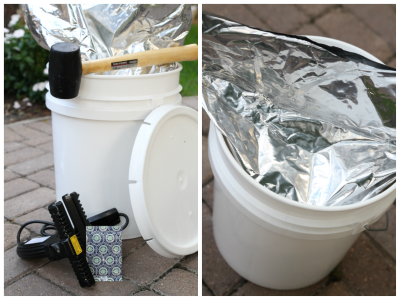
3- Mylar Bags w/ Oxygen Absorbers
This is the method I prefer and the one the pros use. Most companies you buy pre-packaged buckets of food do it this way. Plastic buckets alone are slightly porous and will still allow for air to transfer through them. Using Mylar bags with buckets cuts the oxygen down to almost nothing, helping to preserve your food for 25+ years.
1- Get Your Supplies:
BUCKETS – You want food grade buckets.
MYLAR BAGS – 20″ x 30″ bag
OXYGEN ABSORBERS – 2000 cc for a 5 gallon bucket
SEALER – You can use a hand-held sealer, iron, or flat-iron.
GAMMA LIDS – I use these only on my 5 buckets in the pantry.
REGULAR LIDS – I use these lids on all my buckets, except in the pantry.
RUBBER MALLET – Used to beat the lid on the bucket.
BUCKET OPENER – Helps take the lid off when you’re ready.
BULK FOOD – To fill your buckets.
2- Put Your Mylar Bag into the Bucket:
I prefer 5 gallon buckets, but you can use smaller containers if that’s too heavy, or if you don’t need as much food. If you’re extra buff you can impress us and get 6+ gallon containers, just don’t say I didn’t warn you! They can get extremely heavy, so 5 gallon is my max.
Once you have your bucket, get a mylar bag that fits the size container you are using and put it inside. Mylar bags gives an extra layer of protection that keeps the oxygen, light, humidity and pests out. Anytime someone tells me they had a bug infestation in their food I ask if they used a mylar bag and the answer is always NO, so don’t disregard these bad boys. These bags combined with the bucket, make it nearly impossible for critters to get in.
3- Put Food Into the Mylar Bag:
You may want a helper for this part, preferably not one dripping in ice cream 😉 I’ve never had one, but I’ve dreamt about how I would boss one around, especially as I’m pouring 50 lb bags of food into mylar bags while trying not to spill it all on the floor! Maybe one day…
Anyways, fill the bag up as full as you can, just make sure to leave room so you can put the lid on!
4- Add an Oxygen Absorber:
Do not add an oxygen absorber until you’re ready to seal! As soon as you open up a package of oxygen absorbers they start doing what they do best, absorbing oxygen. Make sure to have all your buckets ready to go with the mylar bags and food inside before you even think of opening the package up. As soon as they are opened, get ready to run around crazy throwing them into all your buckets. The goal is to have all your buckets sealed within about 10-20 minutes after opening the absorbers so they can have the maximum impact possible.
DO NOT USE OXYGEN ABSORBERS WITH SUGAR (unless you like eating bricks)

*For a 5 gallon bucket use a 2000 cc oxygen absorber or you can use 5 of the 300 cc ones.
Size Container
Oxygen Absorber Needed
Quart Jar or 32 oz container 100 cc
#10 can or 1-gallon container 300 cc
5 or 6 gallon bucket 1500cc – 2000cc
If you’re planning on using the leftover oxygen absorbers, you want to make sure you seal those back up ASAP. Often times I use the package they came in and re-seal it with my hand-held sealer, or you can repackage them in a vacuum-sealed bag, or store them in an appropriate sized canning jar with a tight-fitting lid. If possible, try to buy smaller packages of oxygen absorbers so they can be used all at once.

5- Seal the Mylar Bag
Once the bag is filled and the oxygen absorber is added, it’s time to seal the mylar bag. I went ahead and bought a hand-held sealer, which I love! Best birthday present I’ve bought myself so far. You just go along the very top edge of the bag and melt the bag together to form an airtight seal. I leave a little opening at the end, squish as much air out as possible, and then finish sealing the corner.

You don’t have to wait until your birthday to buy yourself a hand-held sealer – a clothes iron, or even a flat-iron you use for your hair will do the trick. Just lay a board on top of the bucket, lay the bag on top, and iron away! You might want to cut a strip of the bag off to test beforehand to get the correct temperature setting, or if your impatient like I am, just go for it.

Make sure your bag is completely sealed, you don’t want any air creeping in. If the temperature is too high it will destroy the strength of the bag, but if it’s too cool the seam will pull apart fairly easy.
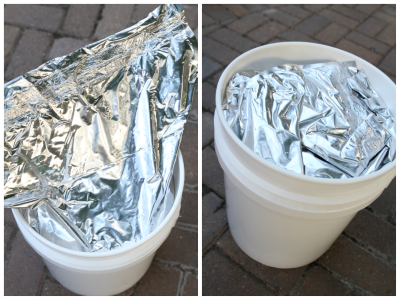
The bag may seem monstrous for the bucket, but that’s good. If you seal close to the top edge of the bag (above is an awful example), you can cut right below the seal when you open it and REUSE the bag! It can be reused over and over again, all you need to replace is the oxygen absorber.
6- Beat the Lid in Place
You can try to tap the lid in place, but until you lose control and start beating the crap out of it, the lid isn’t going anywhere. This is a great project to do after you’ve walked in on your boys while they’re painting themselves to look like Darth Vader and giving their room a Death Star makeover!

Gamma vs Regular Lids: Which Lid Should You Use?
GAMMA LIDS – These twist on lids allow for easy access to the contents of your bucket which is one reason I prefer to put these on the buckets I have in my pantry. I can quickly twist the lid off to get the food out and then twist it back on. Some people put these on all their buckets, but the main issue is they are more expensive! They usually run about $4-6 more than regular lids, which can add up fast when buying 30+ buckets!
REGULAR LIDS – I prefer these for most my buckets because they are cheaper, stack easy, and create a good seal. If you are needing to get into your bucket often though, definitely go with the gamma lid if possible.
7- Label Buckets
I spent 2 hours peeling labels off my sister’s buckets, because we had to refill them and they needed a new year. After that, I had a brilliant idea! Instead of always needing to put a whole new label on, why not just put the year on some easy to remove tape. Ingenious, I know!!!
Since I already did the math and figured out what I want in each of my buckets, I went ahead and printed labels with the food item for each bucket. I don’t plan on changing the contents of the bucket so I went ahead and made sure to tape it on good! The year is changing every time it’s re-filled though, so I put the year on a separate piece of tape! Now I won’t ever be scraping tape and labels off buckets again! Maybe it doesn’t look as nice, but at least it won’t take me 2 hours to change the date!
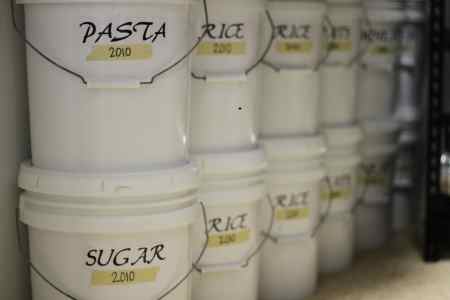
8 – Store in a Cool/Dry/Dark Place 🙂
Just like everything else, you want to store your food in the coolest, driest, and darkest place you can find. This is sometimes where you have to be creative and maybe even consider storing some under the bed. When storing, you want to make sure they’re off the ground (so air can flow underneath), and I’m told you don’t want to stack them more than 3 high (they might crack). I like to be a rebel, so mine are stored right on the carpet, and I stack mine 4 high! The biggest concern is making sure they don’t topple over on anyone, especially the kiddos. So whether you decide to follow the rules, or be a rebel, just make sure to be careful!
Opening Your Buckets:
If the bucket lid is new, you’ll need to pull the plastic part off around the lid. Once that is off, use the bucket opener to pry the lid off. Remember to cut as little of the mylar bag as possible if you plan on reusing it. I then take the bag out and pour the food into the corresponding bucket in my pantry.
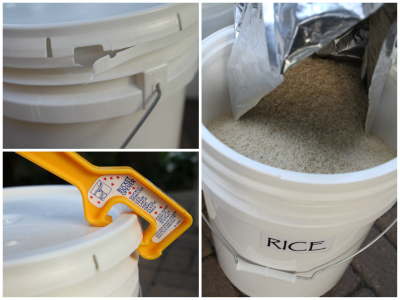
Using Your Food:
I have 5 buckets in my pantry, which contain ONLY the food I’m currently using. With these buckets, instead of the regular lid, I use the twist-on lids known as Gamma Seal Lids. Mine are all boring white, but you can be fun and get different colors to help keep them organized, or to just add some excitement to your pantry.
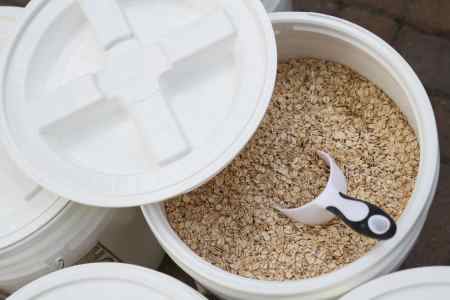
Other Options:
Some other options with storing food is putting multiple smaller mylar bags into one bucket. I don’t necessarily promote this method, because there’s a lot of wasted space and it’s hard to rotate, but I’ve had many people mention they do it.
I prefer to put smaller mylar bags of food into crates or boxes that allow for more bags and are easier to rotate. These smaller mylar bags can be purchased from places like the LDS Canneries and are a great option to use for storing smaller quantities of food like – brown sugar, powdered sugar, spaghetti, etc.
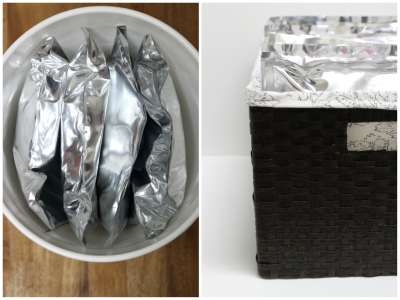
12 Reasons Why You Should Be Thrift Shopping!
Long
before thrift shopping was cool, I was doing it to stretch my budget
and because I just couldn't afford new things. In fact, my parents did
the same thing! I grew up on hand-me-downs until I outgrew my cousin's
clothes. Almost all my books came from used bookstores and the library.
We went to auctions and garage sales. My parents needed to stretch their pennies too!
Now thrift shopping is cool. Thrift
stores are gaining popularity as are the "for sale" or "garage sale"
groups on Facebook. Craigslist is still going strong and eBay is still a
great place to unload your used but still in great condition goods.
Consignment shops are still a good place to buy and unload your good
condition goods (and make a little extra money!). Garage sales are still
fun places to shop!
I have a lot of fun thrift shopping as
long as I don't go overboard. I want you all to be thrift shoppers too.
If you are, but know someone who should be, show them this post!
12 Reasons Why You Should Be Thrift Shopping!
1. Thrift shopping is sustainable.
If you are even a little bit concerned about our planet, you know there
are way too many goods being produced today. More than can be used
actually, but people still demand and buy them. By buying used, you are
breaking that cycle and keeping perfectly good things from going to the
landfill. To keep the sustainability cycle going, you should use those
used goods until they are completely worn out or pass them on to someone
who can use it.
2. You are a non-consumer. As
stated in #1, you are breaking the consumerism cycle. When you purchase
something used, you are a non-consumer. You are not buying something
new. You are not supporting the mass merchandisers. You are not
succumbing to advertising telling you need something new. You are using
what someone doesn't need anymore and you are not supporting people who
have no interest in your local economy.
3. Thrift shopping supports your local economy!
Whether you buy something from a used goods store or a person, your
money stays right in that area. Your money isn't going to some big
corporation who cares very little about you. Your money is going to a
local organization (except Goodwill) or people who will in turn spend
that money locally.
4. Why buy new when used will do? This
phrase is attributed to a certain person, but honestly it has been
around awhile. Why? Because it is true! Used is just as good as new in
most situations. Most of my clothes and my kids' clothes were used
growing up. We got new things for gifts at birthdays and holidays, but
otherwise they were used. Even when they were in high school, we
regularly found almost new and new clothes for them at the thrift store.
I still buy almost all of my clothes used because you can't beat the
prices!
5. You save money! Doesn't
everyone like to save money? You can outfit an apartment or a house for
hundreds of dollars cheaper than buying new. Does buying used things
gross you out? Wash them once and get over it. You are saving money!
6. If you have kids, you are teaching them frugality.
My kids liked to go to the thrift stores and garage sales growing up.
They still do even as teenagers and young adults. They also have found a
lot of great things there. They learned one way of being frugal and
they learned that used things were not gross. The younger they learn
that, the better.
7. You will find brand new things while thrift shopping. Honestly,
this is the best. People are often too lazy to return something to the
store or cannot return it so they will just donate it to the thrift
store or sell on a garage sale. Their loss is your gain because, most of
the time, you will get it for only a few dollars. Score!
8. Anyone can thrift shop! And I
do mean anyone. Some of the most financially stable people I know are
avid used goods shoppers. They love a good deal and refuse to pay full
price. Let's take some tips from those people, shall we? You can be a
prepper, homesteader, parent, retiree, single, married, young, old,
rich, poor, and anything else you can identify with. Anyone can be a
thrift shopper!
9. You can find really good presents while thrift shopping. I
have found a lot of presents while thrift shopping. Books that look
brand new. Clothes with tags still on them. Sets of dishes still in the
original sealed box. Candle sticks and vases because I know people that
collect them. You get the hint. Start your gift shopping at the thrift
store or online consignment sites and go from there.
10. Once you start, you won't be able to stop.
I know that sounds pompous, but it is true. The idea you will be saving
money and scoring some really good stuff is addicting. When you realize
you can do this all the time, you will be hooked!
11. The inventory is always changing.
If you can't find what you are looking for one day, wait a few days and
come back to the store/check again online. More than likely, you will
find what you want at a price that is reasonable or cheap.
12. Thrift stores have sales too.
They get a lot of things donated or consigned to them. They often do
not have the storage for these things so they run sales. Our local
stores often run a buy 1 get 1 free or buy 2 get one free sales. They
also have bag sales where a bag of goods is five dollars no matter what
you have in the bag. I know other thrift stores will have 50% off sales
and more. Keep your eyes open and you will find even better deals at the
thrift stores.
25 Things I Wish I Knew About Prepping When I Started Out
n 2001, I was in my office at work and watched in horror with my colleagues as the second plane hit the towers and our world changed forever. Even hundreds of miles away, it was a devastating catastrophe. Just two short years later, in August of 2003, I was living just west of Cleveland when the Northeast blackout of August 2003 happened.
I was lucky enough to get to the store for ice and batteries before it closed. A security guard at the door stopped me to tell me I had to wait until the previous customer came out before I could go in. They were only letting one customer in at a time. A line of people started to form behind me.When it was my turn, the guard waved me inside. The lights were out but it was daylight so there was enough light from the windows to see by. The cashier followed me as I got the things I needed and headed for the checkout. She added my items on a battery powered calculator and gave me the total.
I paid in cash, grateful I had just gotten paid and had cash on me because with the power out, they weren’t accepting anything else. As I came out of the store with my purchases, I heard the guard telling people in the back of the line, now stretched down the sidewalk, that the store was closing.
The power was eventually restored. But that was it for me. I vowed I would never put myself or my children in that kind of situation again. I was going to be more prepared to hunker down for an extended power outage if it happened again. For the first time, I remember thinking “maybe those doomsday preppers aren’t so crazy after all”.
I started reading about prepping and making lists. I have to admit my first instinct was to buy a lot of stuff. But I was living paycheck to paycheck back then, working a full-time job in the next county over and just trying to make ends meet. I had to start small.
I focused on food and I bought a few extra items each time I went to the store. I kept warm clothes and boots in my car in case I broke down. I stocked up on flashlights and batteries and I tried to keep my gas tank full instead of running on fumes. My parents and extended family were all almost an hour away, I had to at least be able to drive to where they were in an emergency.
Despite my best intentions, there were so many mistakes I, like others new to prepping made along the way. As I look back now, here are the 26 things I wish I knew about prepping when I started out:
1. Prepping is an industry
There are people who are in the prepping industry to make money. These people will use scare tactics and hype to sell their products. Preparedness is a smart strategy but don’t let yourself get caught up in the hype. Focus on what you need for your situation and family. Make a plan and stick to it. Remember that even small steps can make a huge difference.2. It’s Not ALL About Gear
When I first started prepping, my instinct was to buy a whole bunch of gear. I printed off the checklists from the various websites and I started buying the gadgets everyone said were a must have to survive. The problem was, I didn’t know how to use any of that gear. Most of it sat in the closet for over a year. If something had happened, I wouldn’t have known how to use a lot of it.3. It’s Impossible to Plan for EVERY. SINGLE. DISASTER
No matter how good a prepper you are or how experienced you are, it’s nearly impossible to plan for every type of situation or emergency that could happen. Focus on what is likely in your own area first and foremost. Gradually build your knowledge and hands-on experience because that’s what will help you adapt to whatever situation crops up.4. Sometimes Old Really is Better
Not everything sold by those in the prepping industry is a quality product. Some of it, especially pre-built bug out bags and first aid kits, are poor quality items stuffed together to get you to pay more. Quality gear does make things easier but only if you have the right skills and knowledge.When looking for gear and equipment, check your local flea markets, thrift stores, yard or garage sales, and estate sales. Older products are made better, more solid, better quality than new ones and many times you get a much better bang for your buck.
5. Reducing Debt is Critical
To truly prepare for a SHTF event, you’ve got to get out from under any debt you may have. Work to pay off credit cards and save an emergency fund in cash. Start paying for everything with cash and consider taking a course, such as the one by Dave Ramsey, to help you become more financially stable.6. Hygiene and Sanitation–It’s More Than Comfort
When I first started prepping, I didn’t understand how critical personal hygiene and sanitation practices would be in a SHTF situation. Sure, it would be more comfortable to be able to shower daily and have access to a flush toilet, but I didn’t believe it was life threatening. It didn’t take long to discover that poor hygiene and the shutdown of sanitation services are a main cause of Illness, infection, and other diseases that can then spread quickly through cities after a natural disaster or SHTF situation.7. Chances Are You’ll Have to Run, Hike, or Fight
During a SHTF event, chances are very good that at some point, you will have to run, hike, or even fight to survive. Fitness, self-defense, and security can be life the lifesaving difference in a SHTF situation. Many people prep for years before realizing how critical it is to prioritize physical fitness and stamina starting today.8. Companies Lie About Their Products (see #1)
Well not all of them outright lie, but many companies are not above misleading customers into purchasing poor quality products. Advertising is very much an industry designed to get you to part with your hard-earned cash. Test everything yourself, before you need to rely on it to save your life.9. Disaster Won’t Wait till I’m Safe at Home
The greatest stockpile and security system in the world won’t help if you’re stuck at work and the kids are trapped at school. Know local school evacuation plans and have a backup meeting place that is central for everyone. Practice getting to it from any location where you could be when SHTF because disaster can strike at any time, not just when you’re safe at home.10. Documenting Identification and Assets is Critical
Following a natural disaster or even during a SHTF event, proving who you are might be not only necessary, but critical to maintaining your freedom. In addition, knowing what you own and being able to show documentation of model numbers and serial numbers or even photos, may be critical to getting reimbursed by insurance companies or other disaster relief organizations.11. Cabin Fever Makes People Crazy
You and your family may end up holed up in an underground bunker, your basement, or even your own home without video games or television. You could be there for days, weeks, months, or even years with very little outside contact.Those of you with kids between the ages of four and seventeen, just let that sink in. No matter how well you and your family or group members get along, being cooped up in one place for weeks or months on end can wreak havoc. Plan for this and have board games, card games, books, and other non-electronic entertainment in your safe room or at your bug out location.
12. Bugging Out Isn’t the First Option or the Best
For new preppers, it may seem like everyone is recommending bugging out in case of emergency. But not only is bugging out not the first option, for all but a rare few, it’s not the best option either. Bugging out is extremely dangerous and should be a last resort, only when you are certain that you home is no longer safe.13. Prepping is a Bottomless Pit
The more you learn about prepping, the more you will begin to realize that prepping can be a bottomless pit. Because it’s impossible to predict with any certainty, what the scenarios are that you may face or what can go wrong, prepping is a never ending and ongoing process. It’s not something you do and forget about. It really is a lifestyle change.15. Canned Food Weighs a LOT–Look for Lighter Alternatives
Stockpiling cans of food or home canned food in jars is great if you’re able to hunker down and ride out a natural disaster or SHTF event. But this kind of food weights a LOT. You’ll not only need sturdy shelving to store it but you’ll need to look for lightweight food alternatives for your bug out bag in the event you need to bug out.16. Waiting for Doomsday Can Be Depressing
The more time you spend learning about emergencies, disasters, and potential SHTF events, the easier it is to become overwhelmed and live from a place of continual fear. Don’t let prepping consume your life. Focus on likely events in your area. Constantly waiting and anticipating a doomsday event can be depressing without balance. Don’t forget to enjoy life in the present moment as you prepare for potential disasters.17. Stockpiling Cash Won’t Save You
While it’s a great idea and a critical necessity to have cash on hand when a disaster happens, stockpiling cash isn’t the only answer. In cases where the power grid is down, cash may quickly become obsolete. Make sure that you are stockpiling physical items and learning skills so that you can use those to barter for items that you may need for your family following a SHTF event.18. Special Needs Mean Special Planning
Every family or group is different, and your disaster planning must take into account any special needs that might impact your ability to survive during or following a SHTF or other event. There are lots of cookie cutter survival plans available, but make sure you customize your survival plan to accommodate any mobility restrictions, special dietary needs, or medical needs of your family.19. For Most, Survival Takes a Village or at least a Group
There are many different types of preppers out there. You’ll read a lot of advice from individuals who believe that bugging out to the wilderness alone is the best policy. A few very experienced individuals could actually survive using this lone wolf strategy. But for most people, surviving long-term will mean relying on extended family members, a community, or other trusted survival groups.20. Talking Too Much Really Can Kill You
Getting prepared is something to be proud of and can provide a sense of relief to know that when SHTF, you’ll be ready. You may be tempted to share your knowledge and new-found lifestyle with other people you know. Choose the people you share information with carefully because talking too much really can kill you if you’re not careful.When SHTF, that neighbor or cashier at the store you told casually about your stockpile may just decide it’s worth coming to your house to get food and water instead of fighting the hordes of people at the local store.
21. You’ll Need a Plan B, C, and D
No matter how prepared you think you are, there are things that can go wrong in a bug out situation or even during a bug in situation. Your stockpile could be confiscated, your bug out route could be blocked, or someone could find your hidden cache, etc. Know in advance what these things could be and create backup plans so that you can adapt quickly to obstacles and pitfalls.22. Solar Power Isn’t Just About Lights
When it comes to planning for power during a grid down situation, most people think first about lighting. But solar power can come in handy for a wide range of activities after a SHTF situation including alternative ways to cook, heat, and even stay warm. Make sure your solar power system is designed with all of these activities in mind, so it will be adequate enough to sustain your family for the long-term.23. You Really Are Going to Use Those School Subjects
One of the most common complaints about our education system is that it teaches things that we won’t use in everyday life. But when you begin to prep, you’ll realize that many of those things you learned in school really will come in handy including:- Geography
- Physics
- Biology
- Chemistry
- Home economics
- Shop class
- Defensive driving
- Health Education
- Gym or Physical Education
24. Practice Might Not Make You Perfect but It Will Make You Faster
One of the things that is important to realize about disaster situations is that many times it’s acting quickly that can give you an edge over others and in some cases, save your life. This is why you’ll hear some people emphasizing that you get hands-on practice using the skills that you are learning or running evacuation or bug out drills. The first instinct for most people is to panic, emotions will run high, and everyone in your group may not be thinking clearly when disaster hits.There are also places to avoid going when SHTF so you don’t become a target or get caught up in a horde of desperate or violent people. The more you’ve planned out and actually practiced what to do in specific situations, the more likely it is that your group will act on instinct and be able to take action quickly.
25. A Plan and a Budget Helps Keep You Sane
The prepping lifestyle is never-ending, and it can be overwhelming. It’s very easy to lose focus or get taken in by the latest “prepping trend”. If you have an overall plan and a budget for your prepping, it can help you stay focused and keep your sanity.Unfortunately, there’s just no one size fits all way to prepare for emergencies, disasters, or a SHTF event. And even when you do plan, you can be almost certain that something or maybe several things won’t go as planned.
But prepping is a great strategy that can certainly give you an edge in a bad situation. It’s definitely worth it. As a much more experienced prepper now than I was several years ago, I hope some of these 25 things I wish I knew about prepping when I started will help you avoid some of these and other common mistakes preppers make.

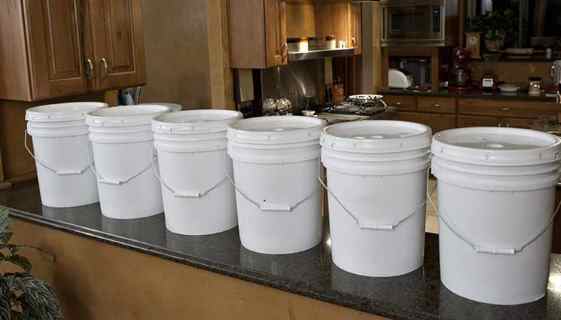
OKAY, WOW...THAT'S THE MOST COMPLETE AND SPECIFIC DISASTER PLAN I'VE SEEN! THANKS ERIC FOR POSTING! LOTS TO ABSORB! SO FAR, WE HAVE WATER, MRE'S, CANNED FOOD, BLANKETS, A SAFE ROOM. I'M STILL CONCERNED ABOUT HAVING SOMETHING TO HEAT UP WATER OR COOK FOOD WITH IF WE HAVE NO POWER...AND YES, FUNDS ARE LIMITED. THE ONE GREATEST THING WE WILL DEPEND ON IS PRAYER AND HEAVEN'S ASSISTANCE. IF IT'S OUR TIME TO GO...MAY WE BE FILLED WITH ENOUGH GRACE FOR THE BEATIFIC VISION!
ReplyDeleteLove that Memes!
ReplyDeleteOnly Jesus can lead us to the hidden manna
ReplyDeleteBut it wouldnt hurt to go with your plan
There is a great tribulation coming
and all the fish in the sea will die
and all the animals on the land will die
and all the trees will die
This is the will of the Father
And man will come to hate God for
what he has done to it
When you see the comet (niburu)
do not drink the water
it shall be made wormwood
and many will die from drinking it
debris from the comet will fall into the
rivers lakes and the oceans
with a rich content of iron
which will kill everything
the sea will turn red